Hello everybody! You may be interested to know about my experience traveling in Morocco.
I need to start by saying that I sincerely love this country ❤️ I have been here three times and each time I discovered more and more beautiful places for myself. The last third visit was the longest. I have visited all the most interesting cities and natural beauties of Morocco.
Below I will show and tell and show what I liked and surprised the most in my trip to Morocco.
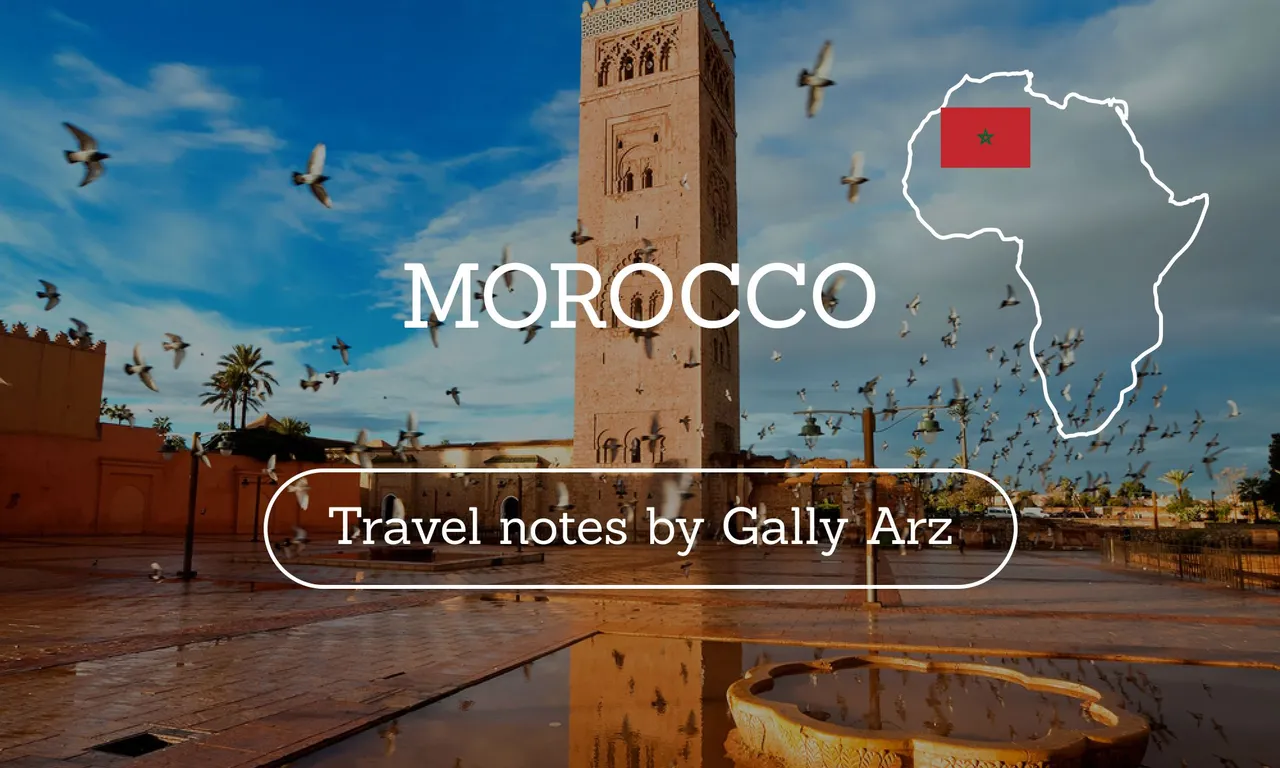
I will try to lay out the routes of all my travels in the Google Spreadsheets template.
Here is a link to my Morocco trip: My Google Docs Planning Sheet
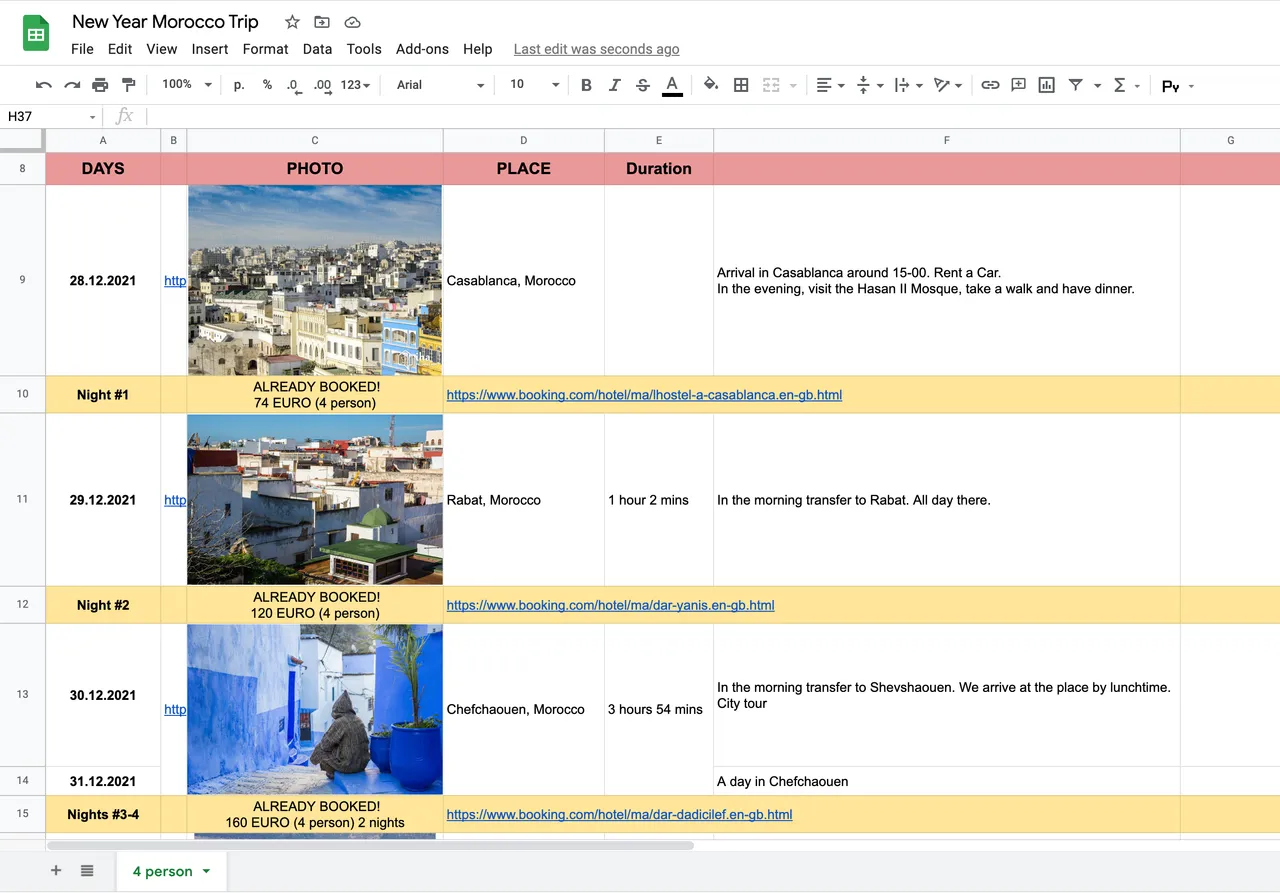
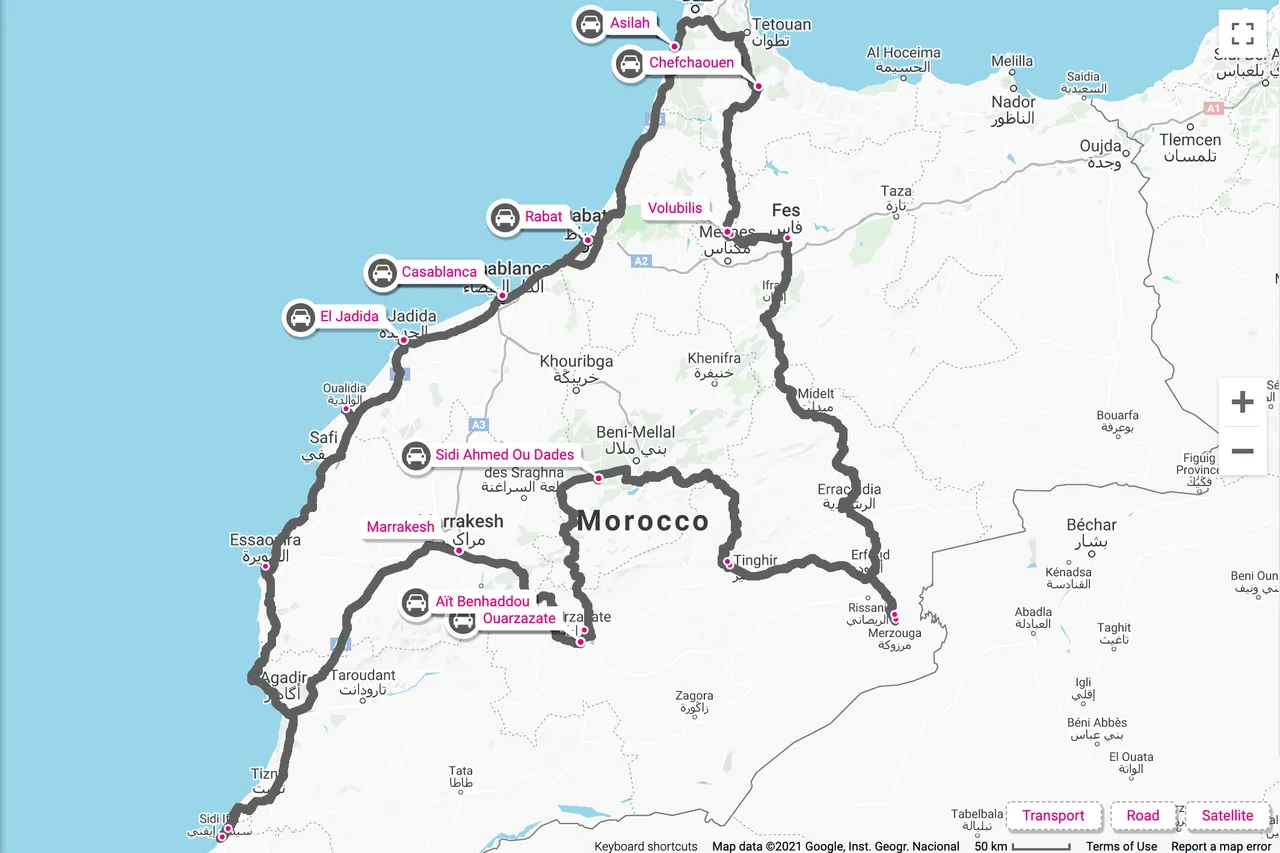
Roads and traffic
Automobile traffic in Morocco is a real battle, a competition of strong-willed characters, where only the most courageous are given a chance to survive. Each participant in this movement - both the driver and the pedestrian - is a maneuvering ace. The first time you find yourself in this mess, you can go crazy in the chaotic stream of cars, mopeds, incessantly talking people, dexterously diving into the narrow streets of the medina. But over time, you get used to it, you become a full participant in these events.
Between the major cities of Morocco there are excellent highways, along which quite modern cars and comfortable buses travel. True, sometimes a miniken with cows or goats drives by, and at the bus stop they try to shove a goat into the luggage of a modern bus.
Once we came in a region of Morocco, where civilization had not yet reached. It must be said that these were the most picturesque hours of our journey. Sometimes people looked at us as if they had never seen a car and European faces in their life 😀

But if you trust Google Maps and deliberately not go to "nowhere", it is almost impossible to find such a thing in modern Morocco.
Parking in Morocco has its own rules. Even if it seems that they are free, there is always a person who will ask you for money. In this case, you need to have a lot of small coins. Usually 5 dirhams are enough for such parking attendants.
Traditional Moroccan food looks like this:
In the history of the country, different traditions intertwined - Middle Eastern, Mediterranean, Western Asia, African, which created the original Moroccan cuisine.
The most famous dishes of Moroccan cuisine, known almost all over the world, are tagine and couscous.
They bake a Moroccan pancake (aka Iraqi, Yemeni, Syrian), malawah, served with honey, fruit and even fish.
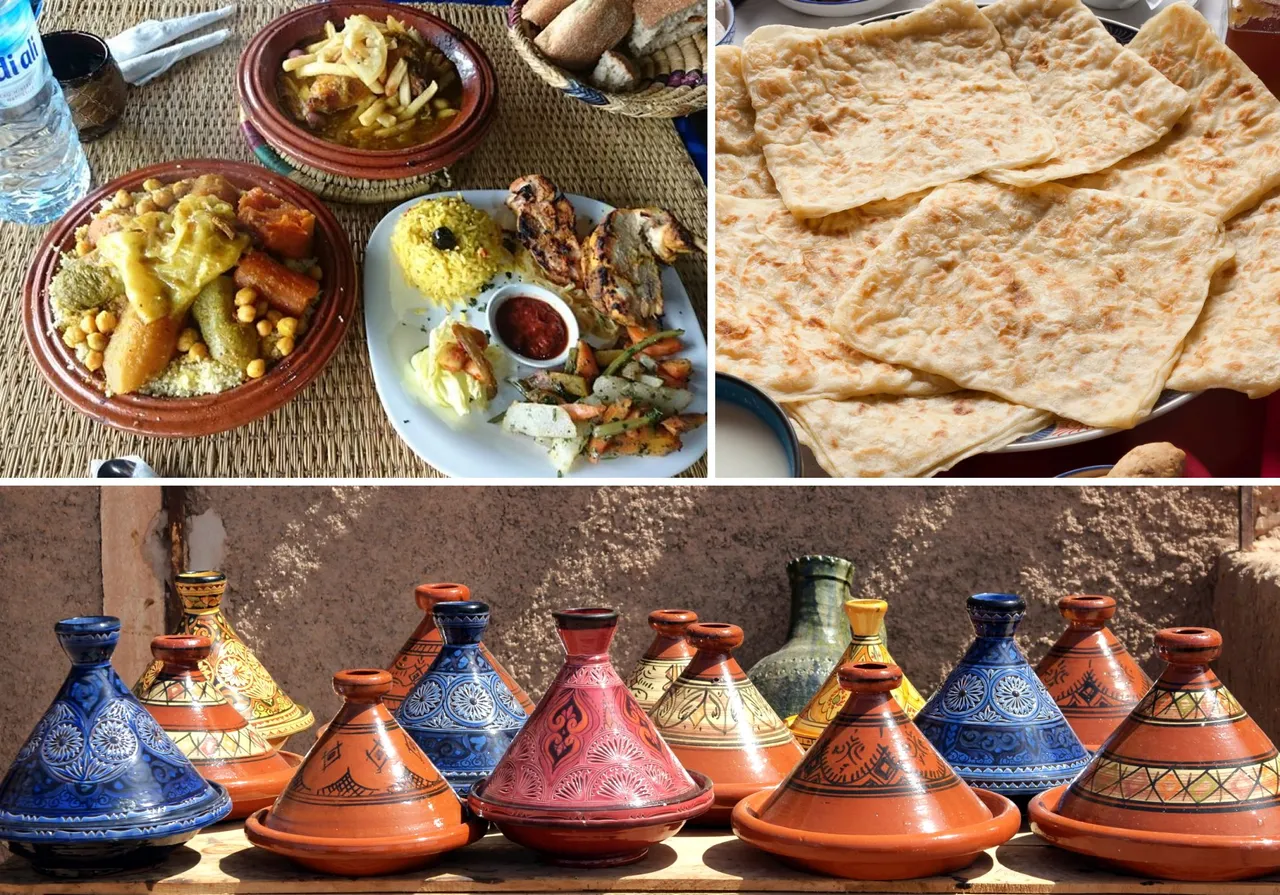
Tea with mint is considered an important addition to food; it is served in traditional tin or silver teapots. In Morocco, tea drinking is considered a special ceremony, which is usually held at home with family and loved ones. Tea is poured into cups in an unusual way: raise the teapot high above the cup and pour it in a thin stream to form a foam.
Coffee is also consumed and served everywhere. Very strong and hot, often with cardamom, it takes some getting used to. Coffee with milk is much less common and is called "kahu kase".
Rabat, Morocco
I love oceanfront cities. Not lakes or seas, but the ocean - so that the roar of waves and fog in the morning, constant wind and salt on the lips. Dream of a tired romantic! 😂
There are exactly two attractions in Rabat.
The first is an old lighthouse, picturesquely towering over the coast. Next to it, you can comfortably sit on one of the rocky ledges and stare into the distance covered with salty haze for a long, long time.
The second attraction is the old Kasbah Udaya, founded by the Almohads back in the XII century. Part of it has survived from those glorious days, although, for the most part, what we see now is the legacy of later eras.
Near the Kasbah there is a small beach, closed from the ocean by a long breakwater. In the summer, they say, there is nowhere for an apple to fall on, but in November there are few who want to swim.
There is a large observation deck on the old fortress wall. In the old days, ships that tried to enter the harbor were fired from cannons from it.
Inside the fortress walls there is an ordinary residential area. Narrow cobbled streets and blank blue and white walls. True, the feeling that we are not in Africa, but somewhere in the south of Portugal or Spain, does not leave for a minute. There is no one on the streets, only happy cats.
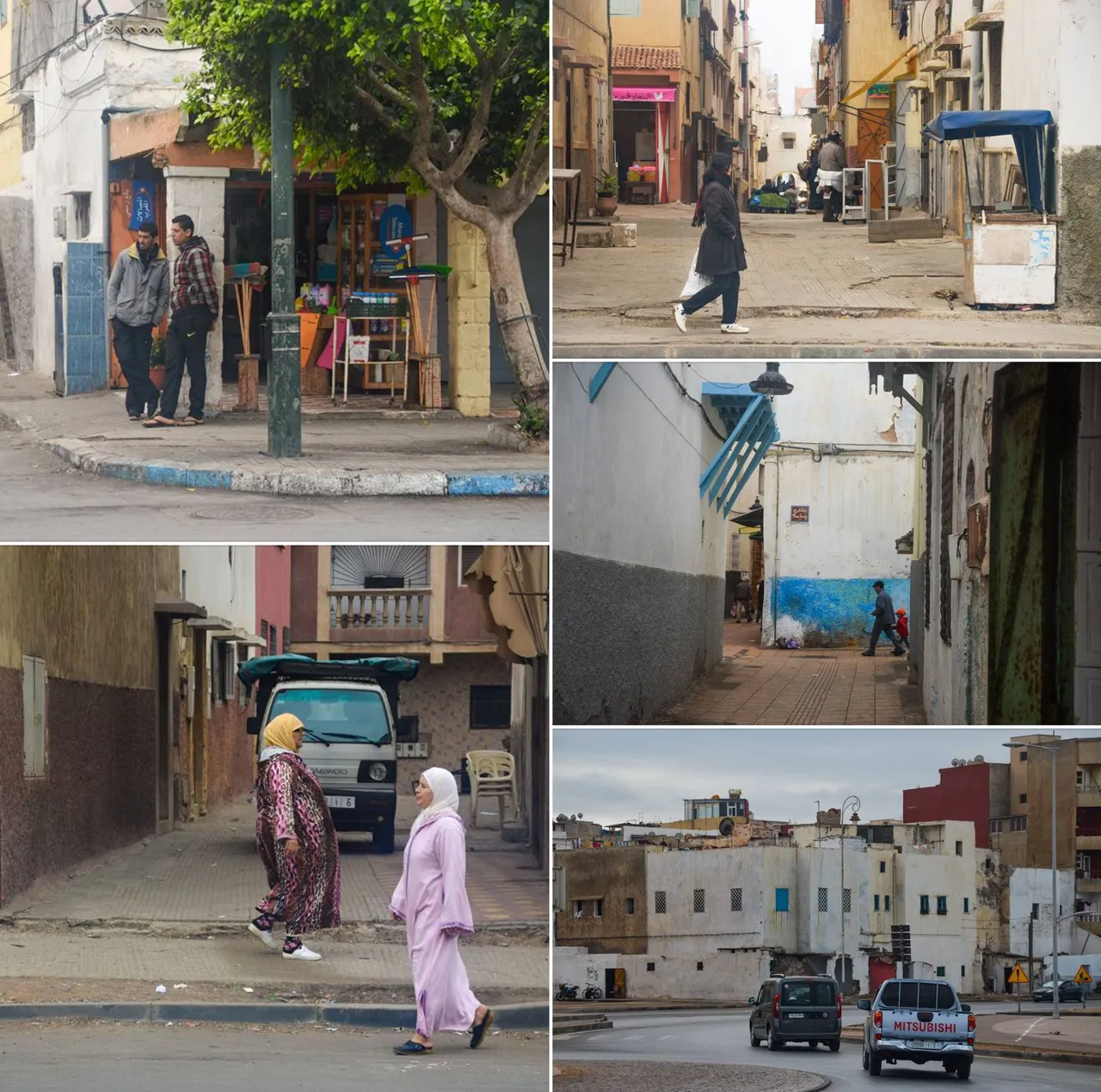
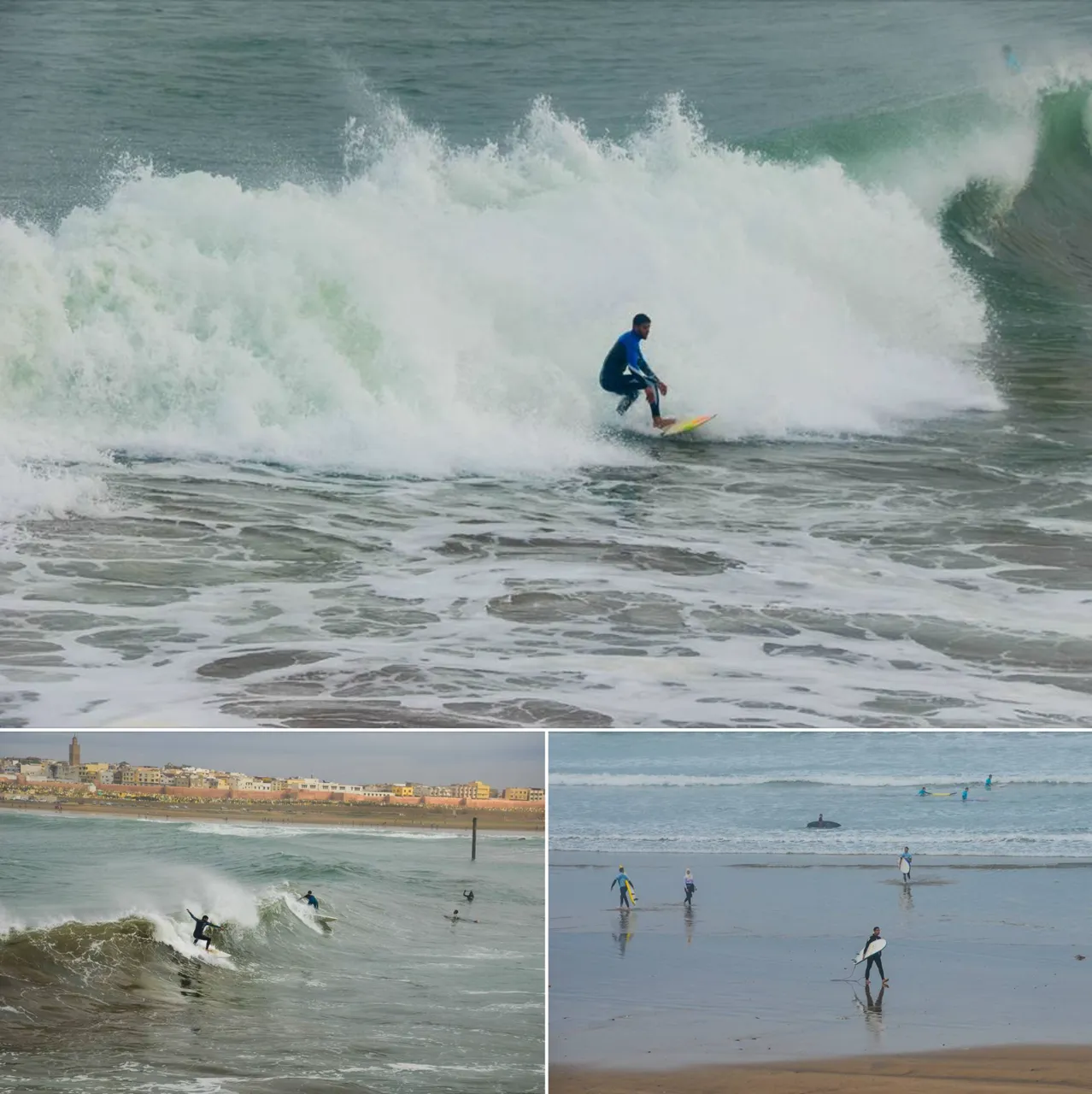
Asilah, Morocco
Asila is a very beautiful and quiet city, most of the city streets are reserved exclusively for walking. In the city, not far from the coast, there is a small and very beautiful medina of blue and white tones. All the walls of the medina have turned into unique paintings (similar to graffiti), which are changed every year during the art festival. Part of the medina faces the sea and the dam presents a beautiful, wide panorama.
Asilah is a beautiful fishing town with many restaurants serving delicious and freshest seafood.
Today Asila is a living National Monument, which is known for its beauty, atmosphere of creativity, is famous for the friendliness of local residents, clean and well-groomed streets. The city is one of the most impressive sights in Morocco, its medina is an example of an architectural wonder.
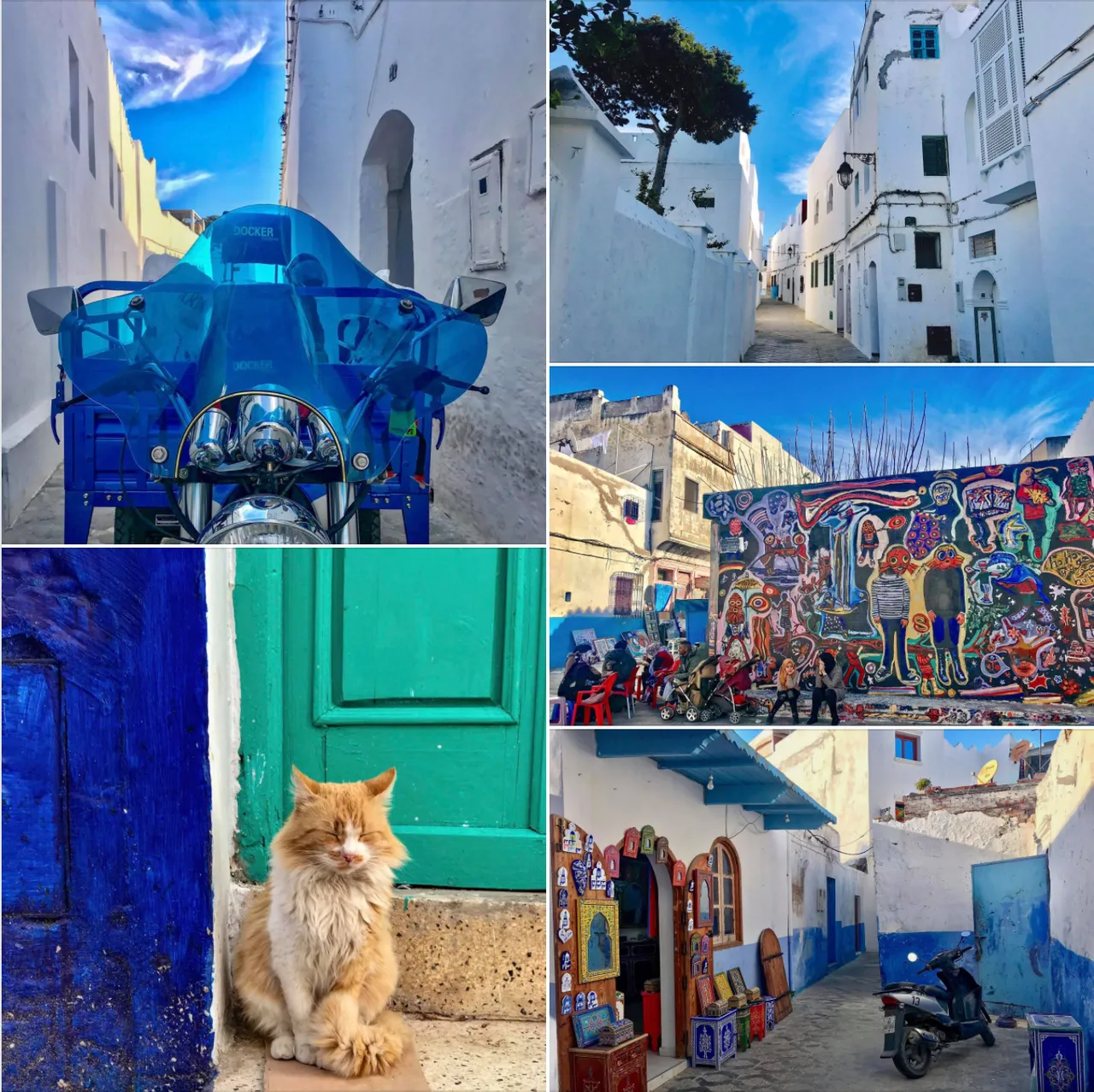
Chefchaouen, Morocco
It is known that Chefchaouen was founded in 1471, inhabited by Muslim Moors and Jews when they were evicted from Spanish Andalusia. The city was declared a sacred place, surrounded by a fortress wall and the gentiles were forbidden to appear in it. Perhaps this is what preserved the medieval appearance of the city.
Andalusian Jews began to paint houses in a color close to the color of the sky. It became a symbol of peace and tolerance, as the city welcomed more and more refugees from Spain. Nowadays there is little to remember about Jewish culture, but an attentive traveler will see such signs, which are more than 500 years old.
Residents, realizing that the unusual color and medieval architecture attracts tourists, diligently support the traditions, although many can no longer explain where such customs came from.
A good shot here lies in wait for every turn, and after a few hours, from the abundance of all shades of blue, it begins to ripple in the eyes. Perhaps this is one of the most amazing cities in the world that I have visited. And just for the sake of meeting him, it is worth coming to Morocco!

Volubilis & Moulay-Idris, Morocco
There were only a few Roman cities on the territory of modern Morocco, and now you can only see one of them. This is Volubilis.
The closest large city to the ruins of Volubilis is Meknes, which is about 25 minutes away by car. In addition, very close to Volubilis is the Muslim holy city of Moulay-Idris-Zerhun, named after the descendant of the Prophet Muhammad. It was in this city that the Arabs settled when they occupied this region.
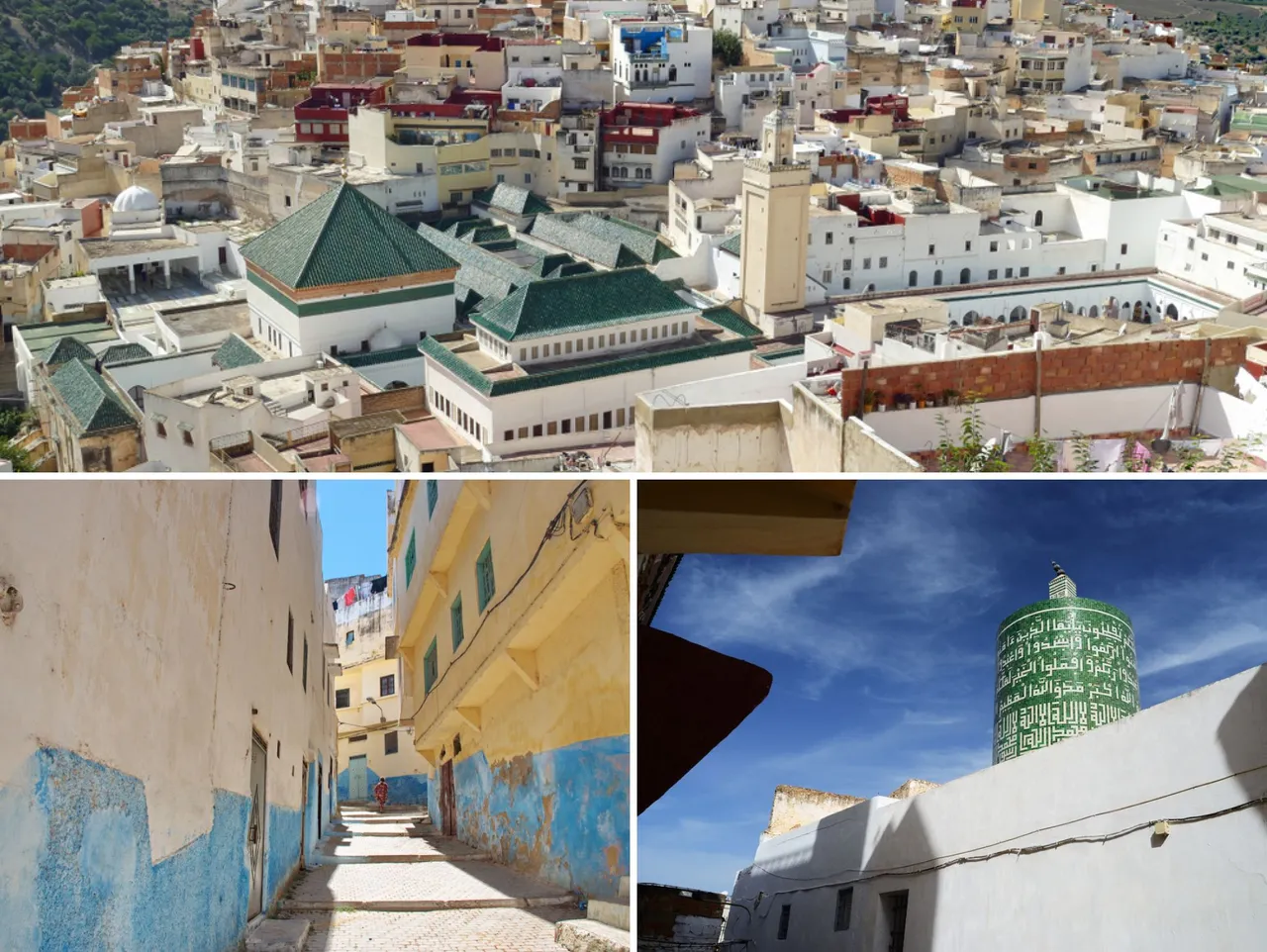
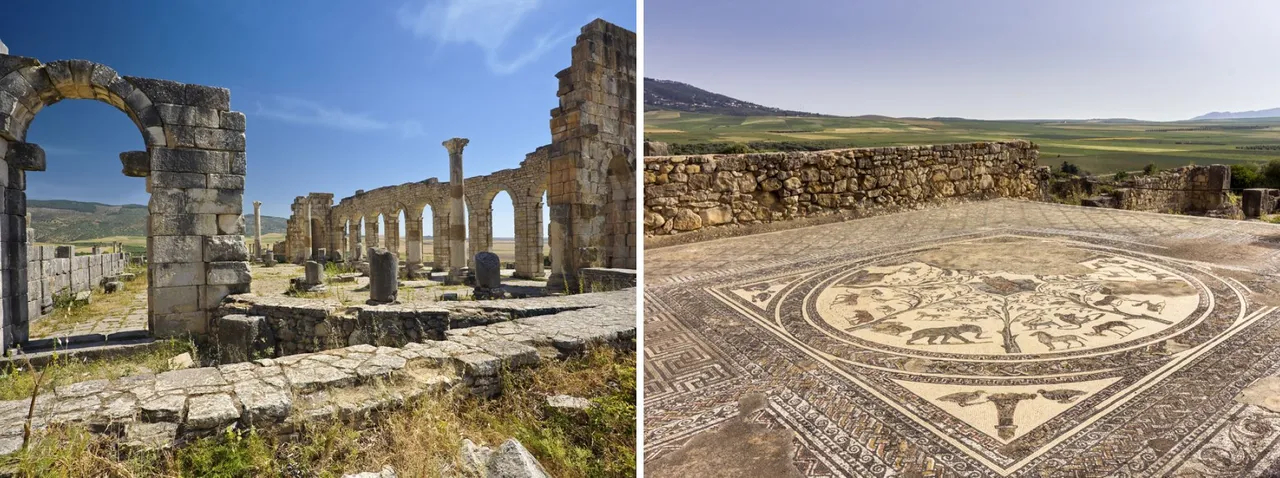
Fez, Morocco
You have probably seen many photographs of leather dyes of all colors of the rainbow, with huge rows of stone baths. Narrow ancient streets with bright goods, red and gold fabrics, shiny dishes. Carved bronze lanterns and fruit piles, surrounded by colorful handmade carpets hanging on the walls. Many of these photos were taken in Fez, one of the oldest cities in the world and one of the four imperial cities of Morocco.
The old town of Fez is surrounded by a medieval wall and is one of the largest pedestrian zones in the world. The movement of vehicles is prohibited here. It also houses one of the oldest in the world the Al-Karaouin religious and educational center (according to the Guinness Book of Records).
Every old Arab city has a bazaar or market. But in Fez it feels like the market is everywhere. It's hard to say what you can't buy here 😀 Here you can buy almost everything: food, ceramics, leather goods, stone, metal, souvenirs. By the way, the market of any Arab city is the best place where you can eat deliciously and inexpensively.
An interesting feature of this place is that there are many hotels, hostels and riads in this labyrinth of streets. But most of the tourists booking a hotel or apartment here do not understand that then they simply cannot find them! Streets, according to various estimates, from 6 to 10 thousand, and mobile communication very often disappears. Therefore, when you book a hotel in the medina of Fez, keep this in mind.
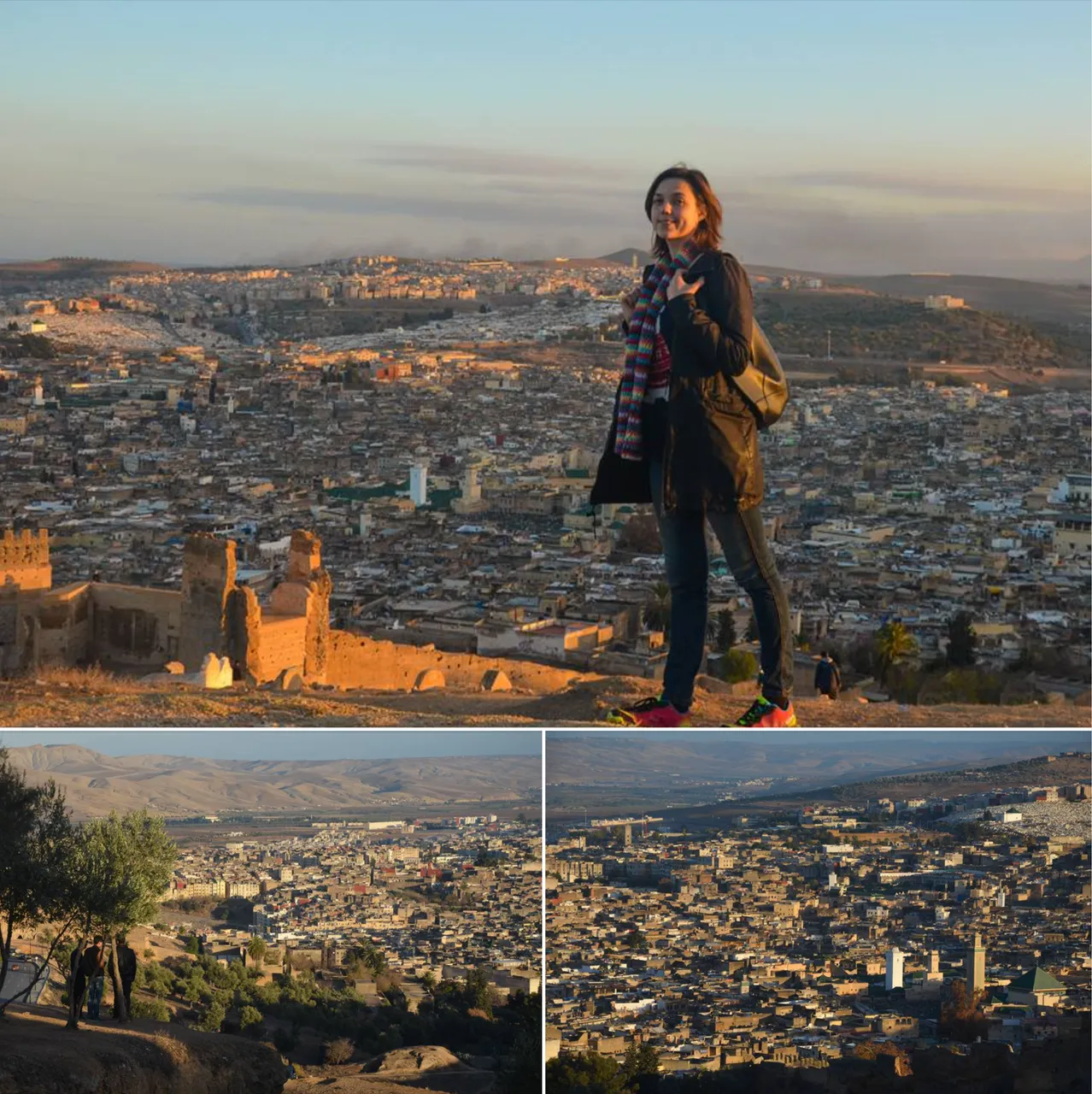
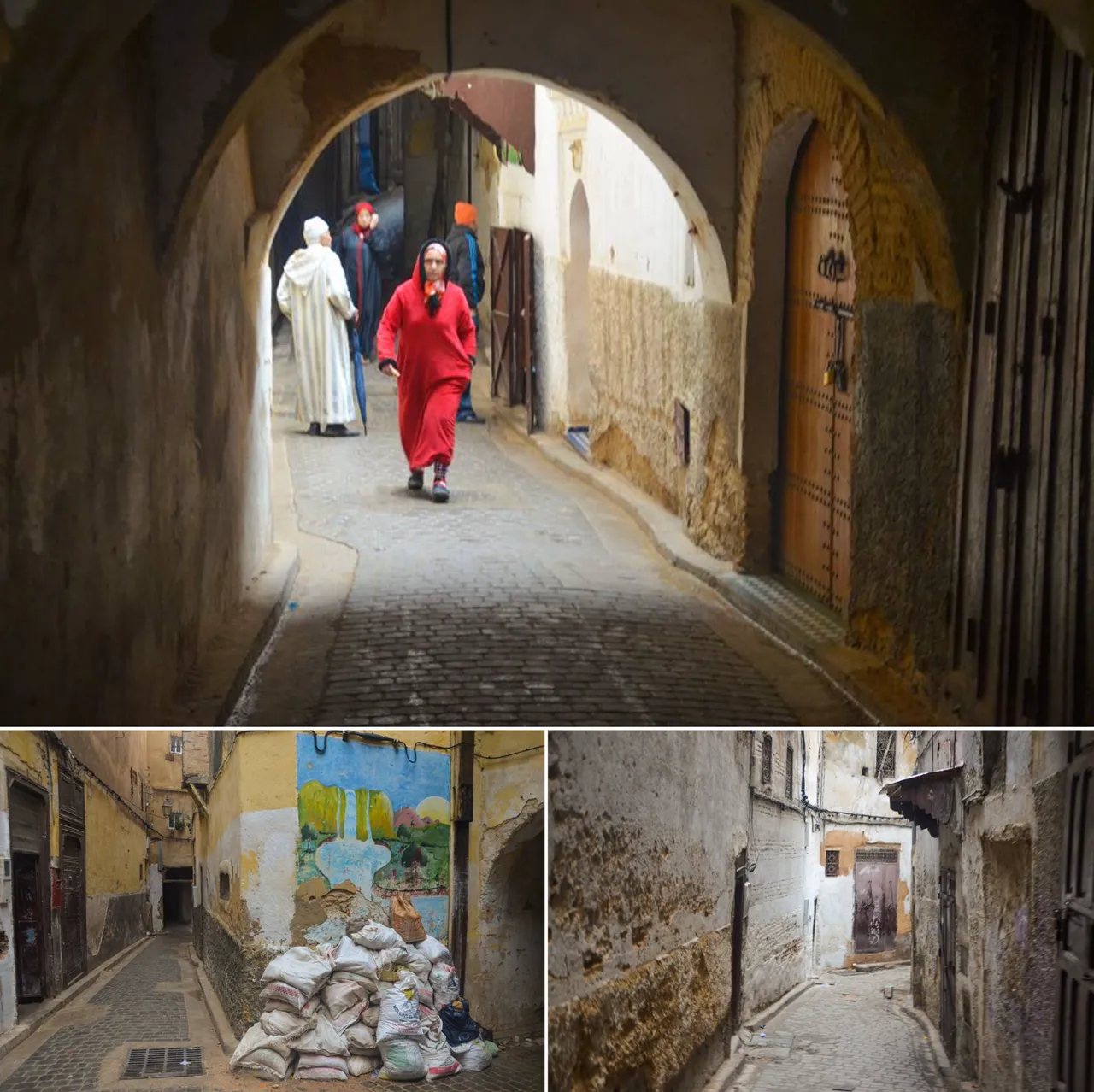
Erg Chebbi & Merzouga, Morocco
In connection with Morocco, everyone will surely remember, except for colored ceramics, clay architecture, tajins and long men's robes, also the orange Moroccan part of the Sahara. This is so typical of Morocco that it is almost unbelievable that desert dunes are located on only a small percentage of this country. The largest and most famous dune is undoubtedly Erg Chebbi.
In fact, Erg Chebbi and Erg Chigaga (the second largest dune in Morocco) are not really even part of the Sahara. This is just sand brought from the desert, which eventually settles in the southeast of Morocco. However, this fact does not detract from the greatness of Erg Chebbi. Compared to the surrounding flat surface, the sand dune rises up to 150 meters.
Desert trips are organized from Merzouga, a small town that today lives mainly from tourism at any time of the year. However, during the summer months, the sand heats up to incredible temperatures, and it is impossible to simply walk on it with bare feet or grab it with your bare hand. The ideal months to visit are spring and fall, when there is also the best chance of seeing clear, starry night skies.
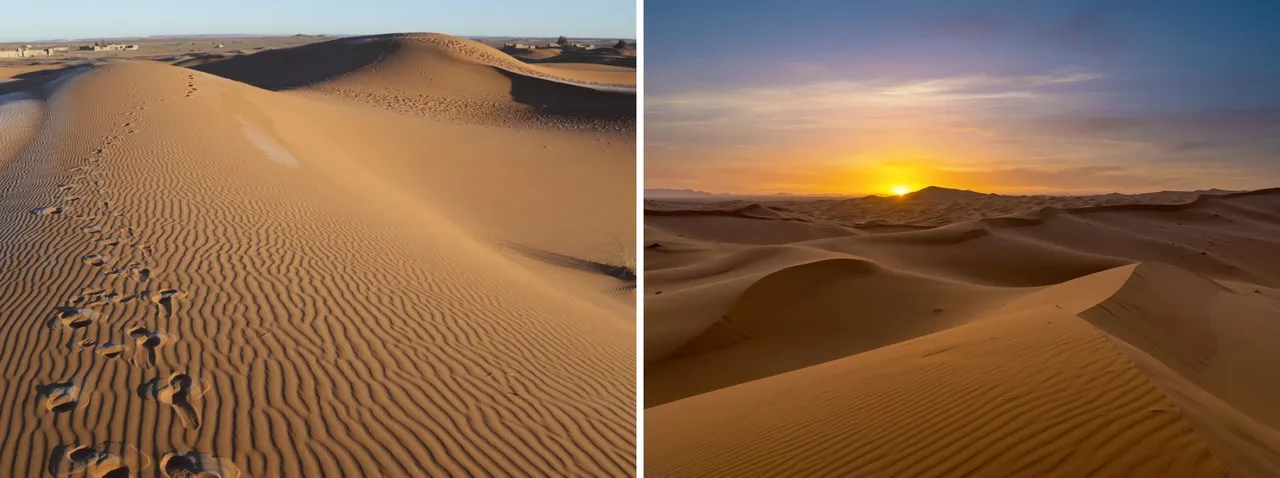
Todra gorge, Morocco
Probably the Todra Gorge is one of the most famous and popular natural attractions in Morocco. You can get here either as part of organized tours / excursions (group or individual), or on your own (for example, by your own or rented car). This place is not among the hard-to-reach and especially remote ones.
Todra (Todgha) Gorge is located in the eastern part of the High Atlas mountain range. The height of the rocks in this gorge in some places reaches 400 meters, but on average it is noticeably lower. The most scenic section is about 600 meters long, which can be easily traversed on foot. The total length of the gorge is 24 kilometers, and its width varies from 10 to 1000 meters. From 10 meters - this is just in the most picturesque area (the height there reaches 160 meters in some places, and many rocks are almost sheer).
If there is an opportunity to look into the Todra gorge is worth it. It is quite impressive, and photographs are hardly able to convey this impression in full. It hardly makes sense to purposefully drive hundreds of kilometers just for the sake of this gorge, but it is usually combined with other attractions. If you wish, you can climb the rocks of the gorge (naturally, if you have experience in rock climbing). This is allowed and practiced by some tourists.
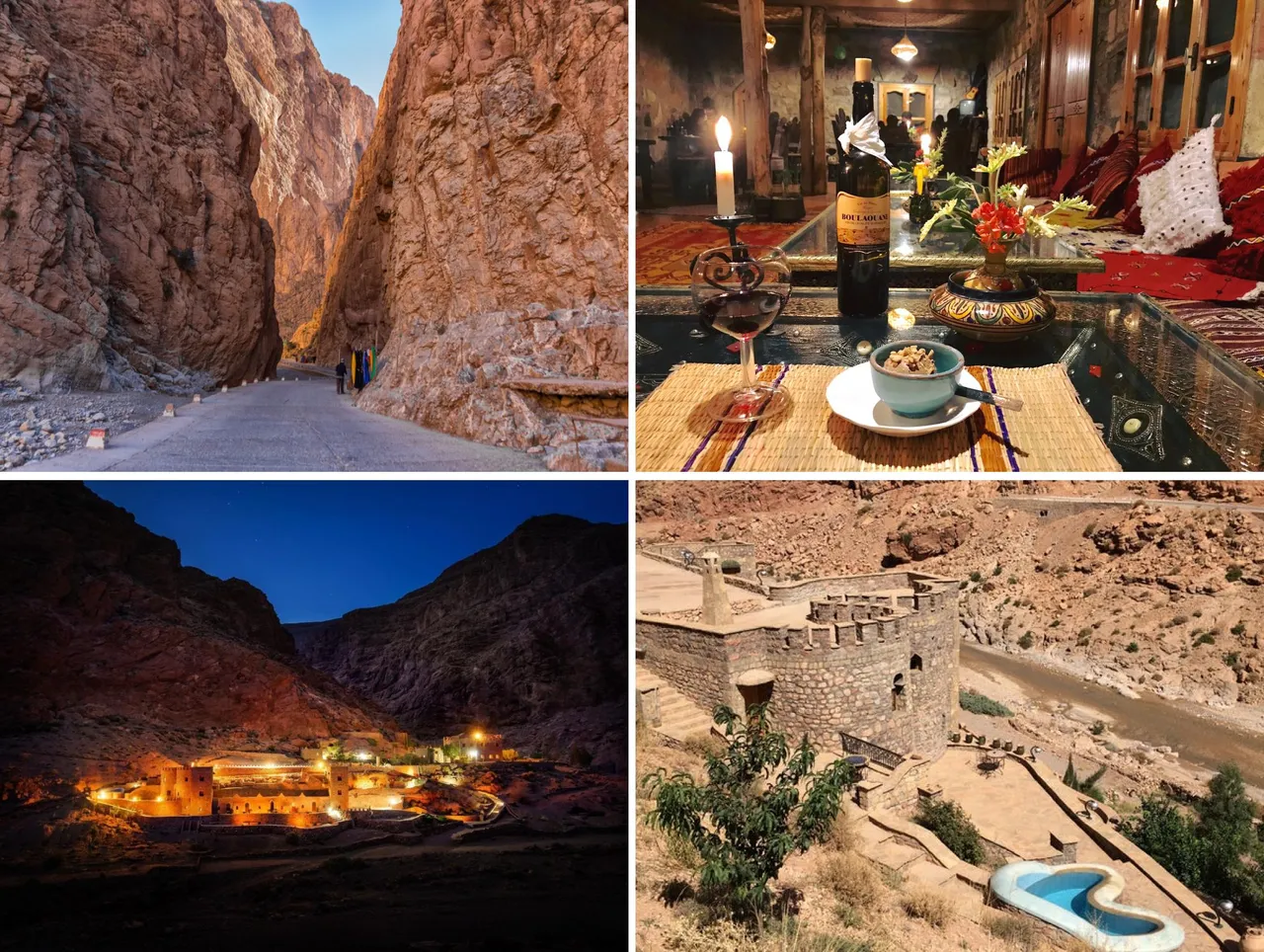
Dades, Morocco
When planning a trip to Morocco, one of the must-see items was a visit to the famous Dades Pass.
The Dades Gorge is located near the town of Dades, which stands on the Dades River, which flows from this gorge into the great Dades Valley. All names are easy to remember 😃
The Dades Valley is also called the Valley of a Thousand Kasbahs. Just because there are a lot of them here. The Kasbah is a folk Moroccan fortress village, even a fortress house. Usually it is a square with four towers at the corners. In them the sedentary inhabitants of the area hid from the raids of the nomads. They are here and the truth on every corner. Some are from a hundred to several hundred years old, some are newer.
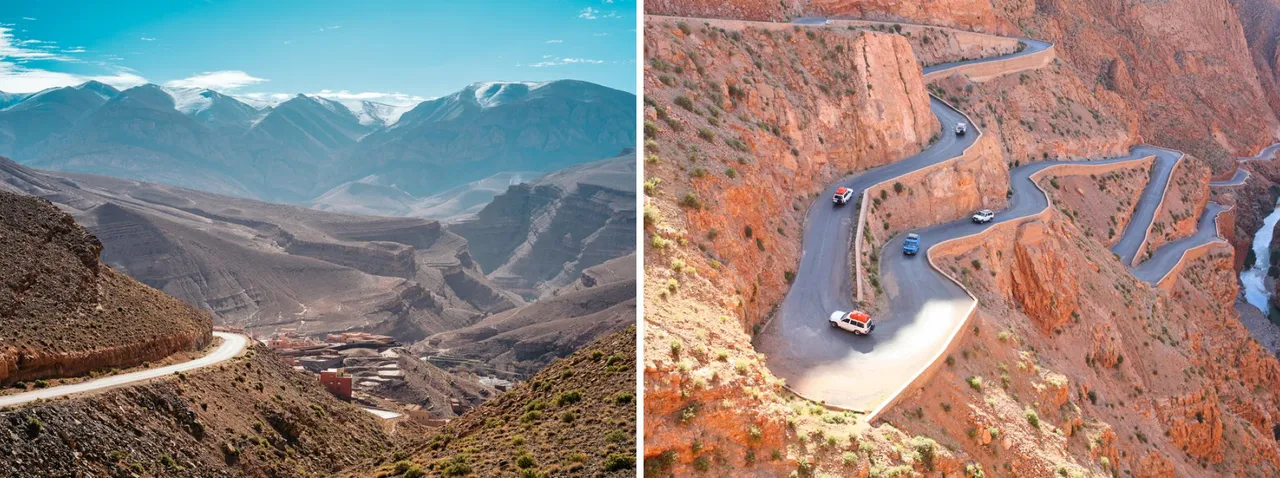
Ksar Ait Ben-Haddou, Morocco
On the road from Merzouga to Essaouira, there is the world's largest ksar - a clay fortress city, completely unearthly in appearance, incredibly ancient and strange. More than fifteen Hollywood films were filmed here, such as Jesus of Nazareth, The Mummy, Gladiator and other historical and fantastic stories. Not far from it there is a huge Hollywood studio, in the pavilions of which some of the same films were filmed. In general, clay architecture is very traditional for Morocco, but it was closer to Ait Ben Hadd that vast, multi-storey cities, sometimes abandoned in the mountainous desert, began to occur. We stopped several times to watch them.
Once this Moroccan fortress occupied a much larger territory, but now only a gate remains from the outer wall. There are officially 4 entrances to the fortress, two are free, and two belong to families living in the Casbah and pass through their houses and yards.
Do not spare a very small amount of money and go through the houses! It is interesting. Granny will be happy to show you the local life, donkeys, carts and simple surroundings. Also, be sure to climb onto the roof! Be surprised that the roof springs slightly under your feet, as it was built from the trunks of thin trees, covered with reeds, and a thick layer of clay was placed on top. But the technology has not changed for a thousand years!
Some houses of Ait Ben Haddou have observation towers decorated with three-dimensional patterns. They partially crumbled. And in general it is surprising that they have somehow survived.
You can go around all the fortresses slowly in 1.5-2 hours, but it is better to meet the sunset at the top, on the mountain, where we climbed! At the very top there is an observation tower, from the foot of which you can see the view all the way to the horizon.
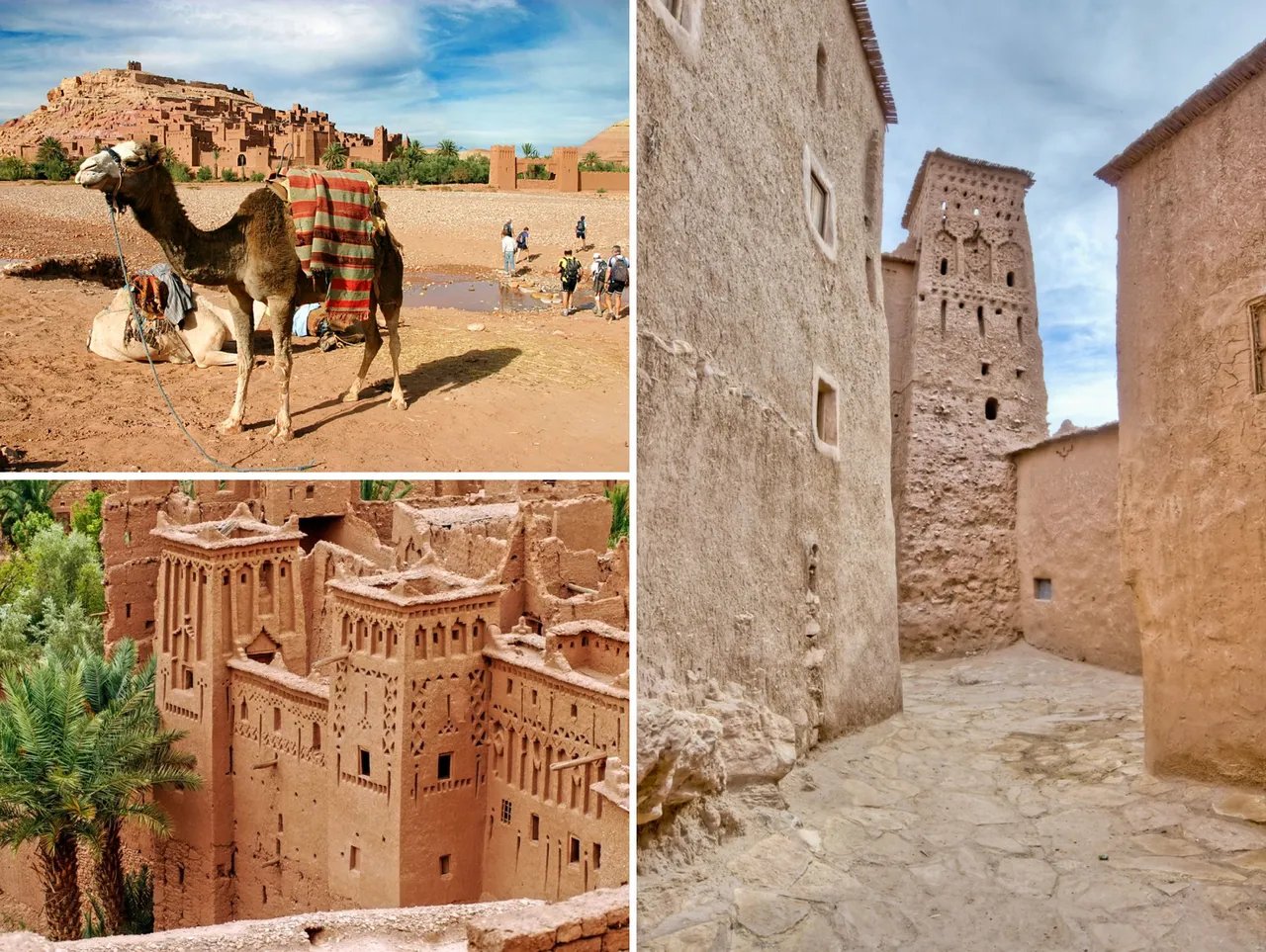
Marrakech, Morocco
Marrakech is the most important of the 4 imperial cities of Morocco. He gave the current name to the country (and in Iran the country is still called "Marrakesh"), for a long time it was its capital, and is still one of the largest (according to the last census, more than a million people live here) centers of culture and education Maghreb. Only here you can see the 11th century medina and the Louis Vuitton store just a kilometer from each other 😀
Now there are a lot of tourists here and many traditional customs have now acquired a slightly artificial format for tourists. Themselves as Moroccans are increasingly leading a Western lifestyle.
Marrakech (also called the "Red City" for the color of the clay from which the local medina is made) is quite a modern city with very heavy traffic on the roads. Moroccans reluctantly change from live transport to motor transport. Donkeys are everywhere. Even at the bus station, along with a taxi, a donkey with a cart stands proudly 😎
Real palaces with beautiful courtyards are hidden behind the nondescript walls of the medina of Marrakech! The architecture of all riad palaces is more or less similar. All beauty is inside. Outside, no frills.
The main square of Djemaa el-Fna lives a stormy life, never stopping day or night. Here you can find goods and entertainment for every taste. Hypnotized cobras, trained animals, fortune tellers, henna painting, amateur fistfights and other joys of life.
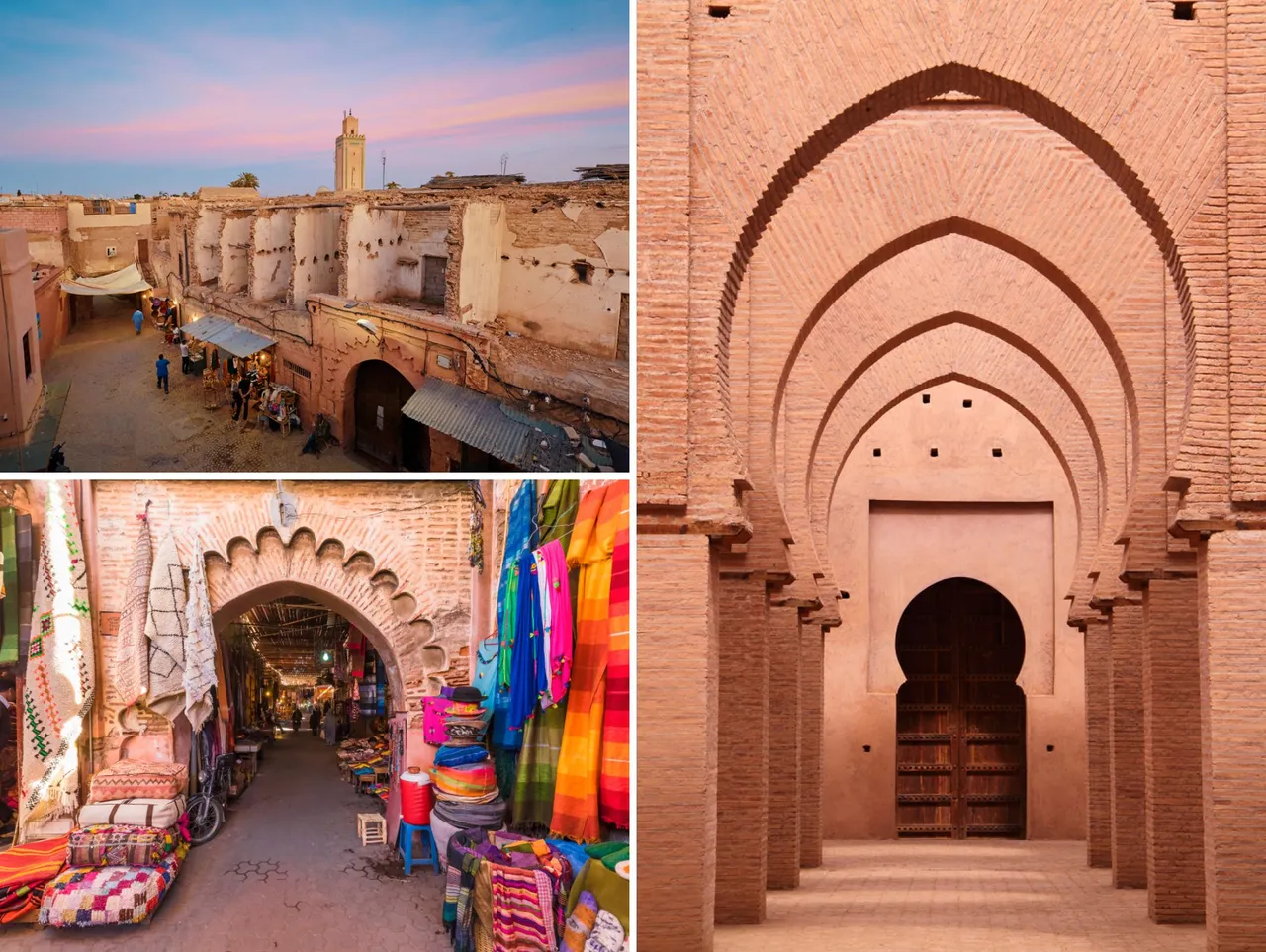
Sidi Ifni, Legzira beach & Mirleft, Morocco
If, while traveling in Morocco, you have become familiar with mosques and medina, you would like to feel like you are in Europe, then go to the south of the country!
On the way to Legzira, there are towns that are very unusual for this country, here you will find a different architecture: white walls, blue windows and doors, Andalusian-style gardens, fountains tiled with ceramic tiles and an atmosphere of lightness.
All this is because this territory was ruled by the Spaniards for a long time! They left here only in 1969. Nowadays, these towns are mostly populated by Muslims, but the atmosphere here is completely different, not like in Agadir or Marrakesh.
In Sidi Ifne tourists are of three types: surfers, elderly couples from Europe and hippies😄 And also those who visit Sidi-Ifni one day at the same time as Legzira. Housing prices are very low.
What can I say, a nice town! There is no special tourist infrastructure here, nor are there any world famous attractions. For those who just want to be in a quiet, cozy place in the Moroccan wilderness on the ocean, without a trash heap, crowds of people and obsessive service!
We are moving north and about 10 km from Sidi Ifni there will be a very beautiful stretch of coastline called Lezgira.
Lezgira beach is constantly included in various selections of the most beautiful places on our planet. Just for the sake of this beach, you can already start packing your bags in Morocco! I think that now many people already know about these places, and that the most beautiful arch collapsed in 2016. It was airy, light and of course she wanted to be in the frame. But no less photogenic powerful arch remained, it is several times larger than the one that collapsed.
The best time to visit Legzira beach is at sunset. It is then that the arches acquire that very reddish tint and the landscape begins to resemble the outlines of a scene from a science fiction film. You need to walk about a kilometer along the beach to the arches. The first arch is the largest.
Do not pay attention that from a distance it looks miniature, this is an optical illusion. The height of its vault is about 20 meters! At high tide, the arch heats up. If the ocean is worried, then it will not be possible to pass without getting wet.
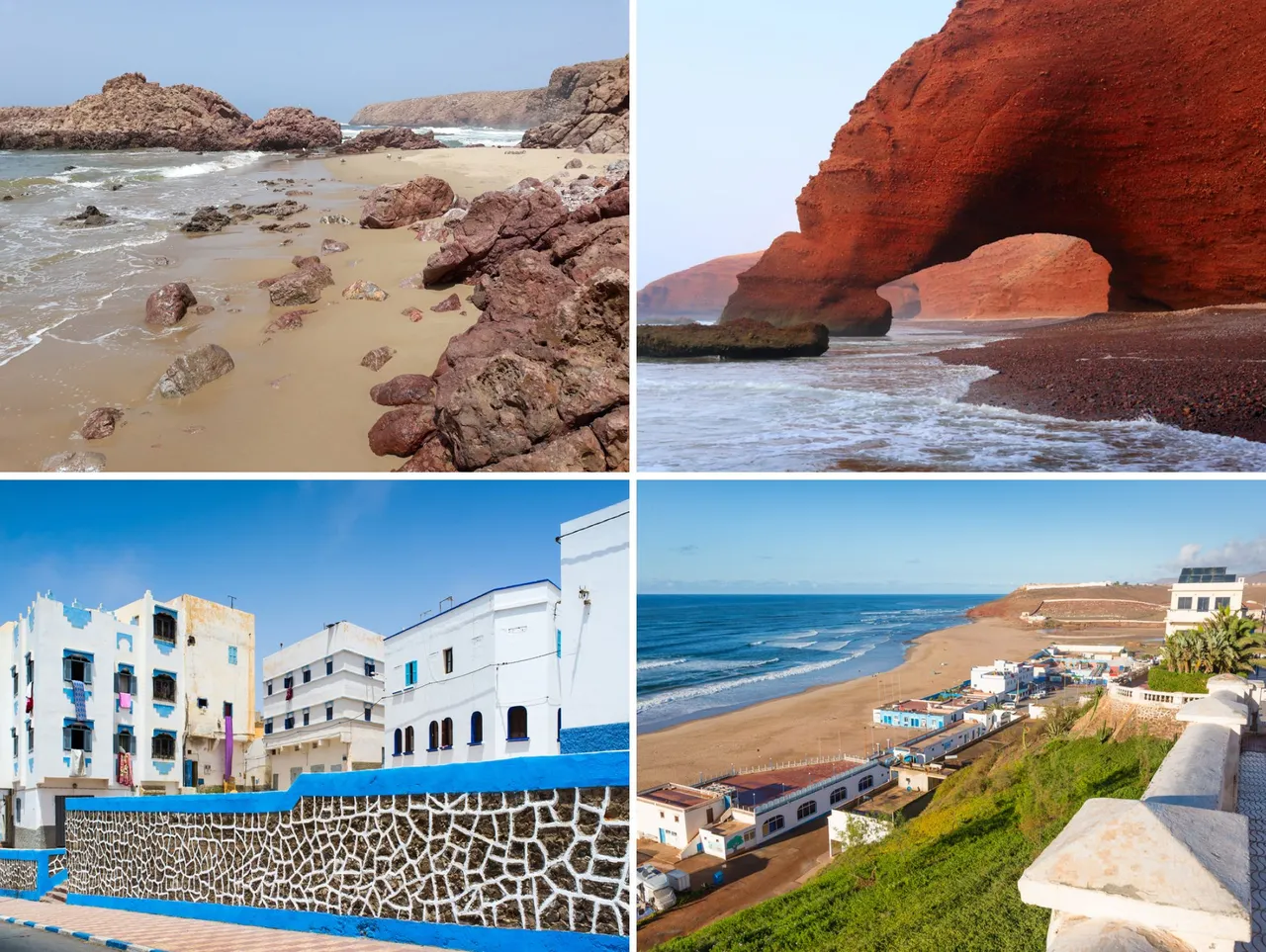
Essaouira, Morocco
Perhaps, after Agadir and Marrakesh, it is Essueira that is the most popular tourist center in Morocco. Moreover, if the first two cities were traditionally centers of trade and tourism, then Essueira some 20 years ago was nothing more than a godforsaken fishing town, where a few European hippies loved to relax. There are all conditions for romantics and idealists looking for their paradise on earth.
Essaouira is the white pearl of Morocco. The former pirate capital, the city of Jimi Hendrix, gnahua music, windsurfing and bohemians of all stripes.
Essaouira is portrayed as the city of Astapor in the Bay of Slavers in the third season of Game of Thrones. It was here, on the walls of the city fortress, that Daenerys Targaryen negotiated the purchase of slave warriors.
The heart of today's Essaouira is the old port located in a bay in the city center. Blue-painted boats are lined up in rows, awaiting their exit to the Atlantic Ocean. Every day in the harbor they arrange a never-ending fish market, where life is in full swing until late in the evening, and seagulls soar in the sky in the hope of grabbing something tasty.
Incidentally, Essaouira was home to the largest (in percentage) Jewish community in Morocco before the declaration of independence in 1956. There were 40% of the population of Jews here, and the Moroccan sultans consistently showed tolerance towards them, since it was Jewish artisans and merchants who to a large extent replenished the state treasury.
Today Essaouira is no longer a quiet fishing harbor where hippies could relax. Now there is a tourist boom and there is no silence either day or night. Dozens of tourist buses every day bring here hundreds and thousands of one-day tourists from Marrakech and Agadir: they rush in crowds along the narrow streets, sweeping away souvenirs and then filling restaurants where the price tags are three times higher than two steps down the alley.
Nevertheless, the town is very pleasant, and in the evening, when the tourists are taken away, it is completely beautiful.
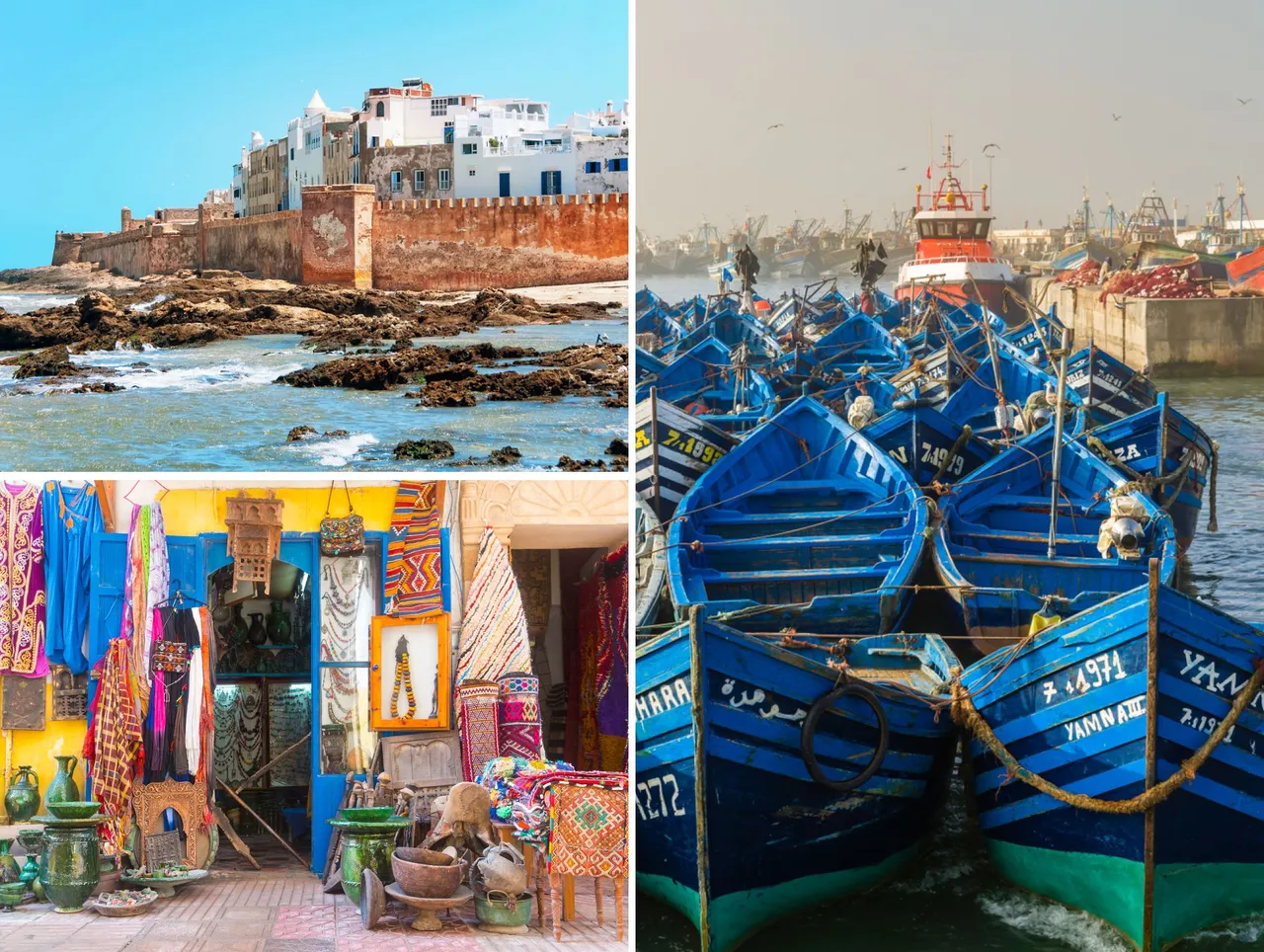

El Jadida, Morocco
In Morocco, the main tourist flows follow certain routes. Marrakech, Fez, Essaouira, Agadir, Merzouga - these places are always full of guests from all over the world. But Morocco is a huge country. It is worth getting off the popular route and you can easily plunge headlong into a real, colorful and unusual local life. This is exactly what happened to us in the port city of El Jadida.
It’s even strange, but for some reason tourists don’t really come to this city. And it is no worse, and in some ways even better than the same Essaouira. There is an amazing Portuguese fortress, ancient cisterns, a luxurious fishing port, a bazaar and, of course, all this is seasoned with insane Moroccan energy. In this contrast, a walk along El Jadida seemed to us especially unusual and filled with the real spirit of North Africa.
The first nice note is that there are no so-called sticky "helpers" in El Jadid. Nobody pursued us or offered their services or demanded money. Apparently, all representatives of this activity left for a long time where there are more tourists at times.
Another point - parking at the walls of the fortress near the entrance was free. You will be surprised, but this is a rarity for the cities of Morocco!
Medina of El Jadida is somehow completely non-touristy and not even Moroccan. It hurts to be quiet and calm here! Although it may just be that we are so lucky. There are a couple of restaurants and a dozen shops on the main street, but there was a feeling that they were all more focused on local residents than on guests of the city.
God knows why El Jadida failed to become a second Casablanca. She had such an opportunity. But on the other hand, why does Morocco need two Casablancas? Now this city is living its own life and it is beautiful in its own way!
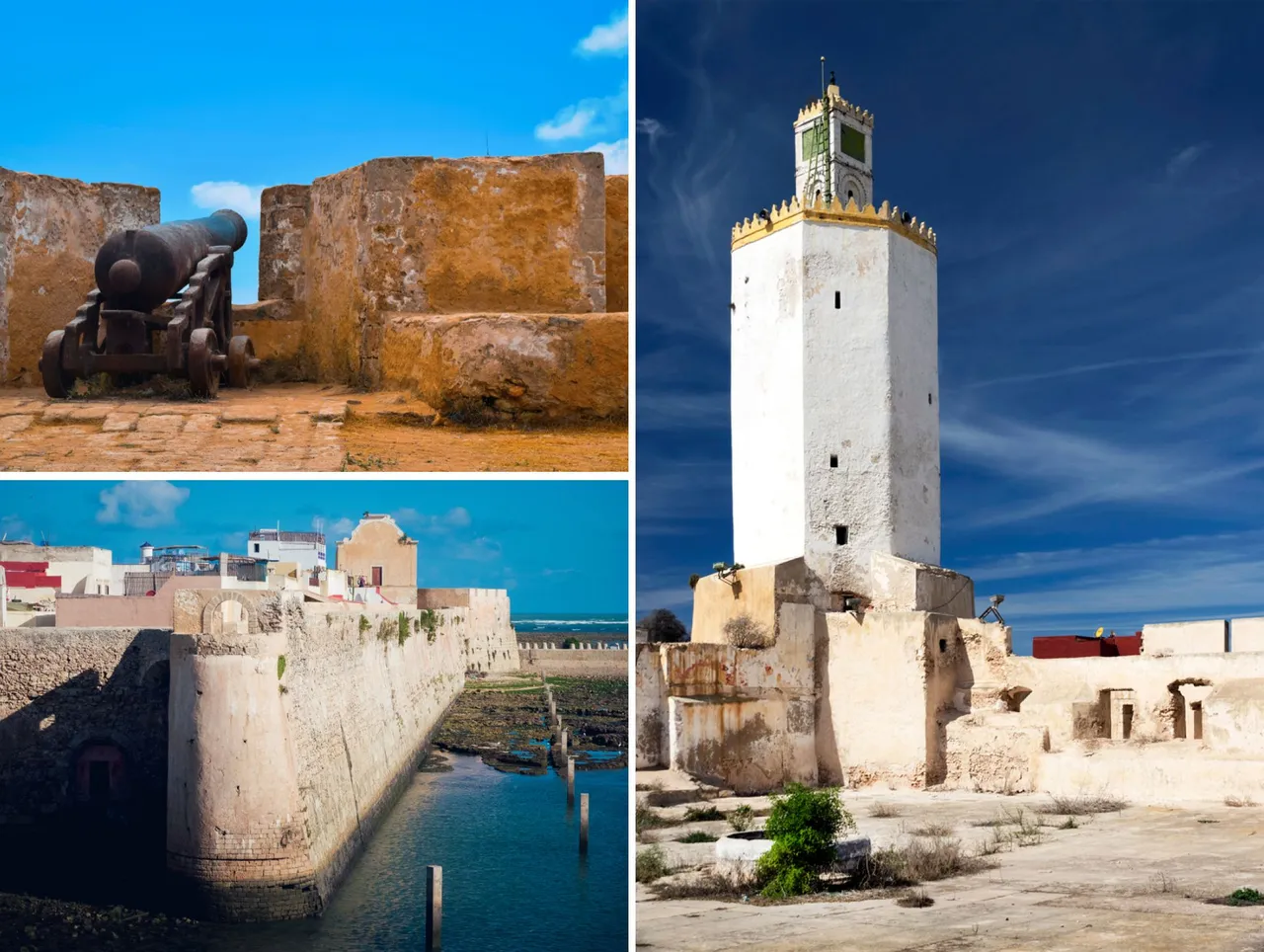
Casablanca, Morocco
With this city, you need to end your Moroccan journey in order to properly understand its uniqueness.
Probably the most controversial city in Morocco. Casablanca attracts as much as it repels. This city is too big, diverse and sometimes defying simple tourist logic. And yet, in its own way, it is beautiful and unusual. Apparently, you cannot find another such city with an explosive mixture of European gloss and Moorish carelessness on our entire globe.
You should definitely come here. Only for a meeting with Casablanca is it worth preparing in advance, and for this you need to familiarize yourself with the experiences of other travelers, both negative and positive. The main thing is that you need to understand well where you are going to go and what you are planning to do there.
Personally, I really liked this city, although this trip was not easy. I am sharing my impressions of the most European city in Africa without Europeans!
After World War II, Casablanca was overrun by Europeans. At that time, they made up almost half of the city's population. In this regard, the legendary American film "Casablanca" of 1942 is very indicative, where among the heroes were the French, Germans, Americans, British, Norwegian, Czech, Bulgarian and not a single Moroccan.
But don't fall for the bookish and cinematic charm of Casablanca. This place has a complex, but interesting history, which clearly does not fit into the standard framework for the development of a Moroccan city by the sea. Although in many ways it is quite comparable with the stories I have already told of Essaouira or El Jadida.
After the French left Morocco, the city experienced a period of depression and mass emigration, but soon the decline gave way to a new flourish. Casablanca is now the largest city in Morocco and the country's most important economic center.
In addition to a huge number of ordinary residential buildings with luxurious art deco elements, you can find many beautiful mansions on city streets, among which it is sometimes difficult to believe that you are actually in Morocco.

Cheers Gally ❤️
See you soon
